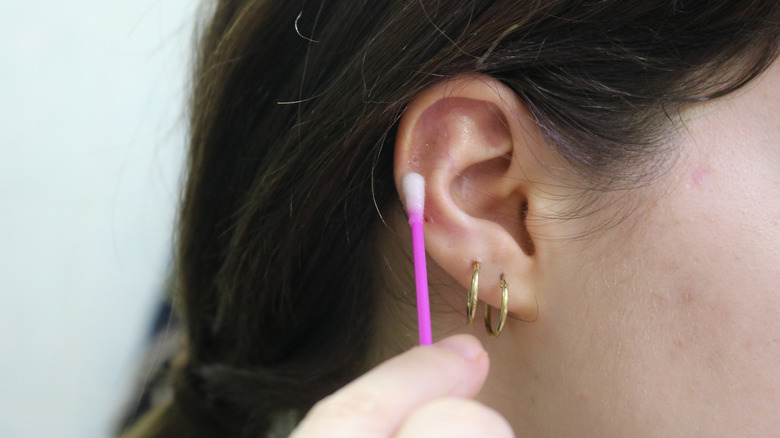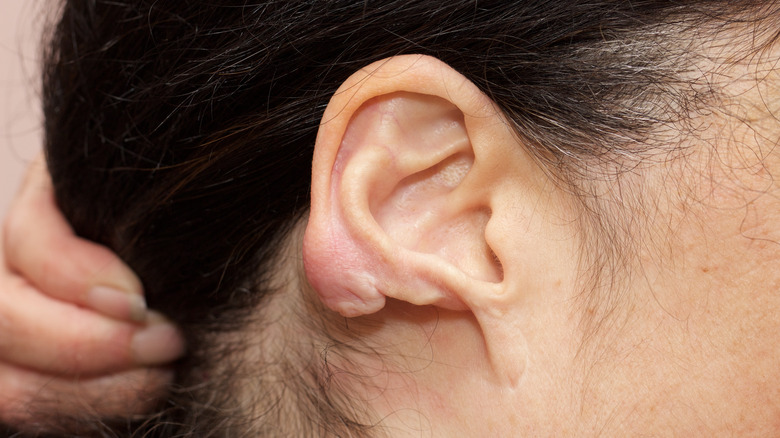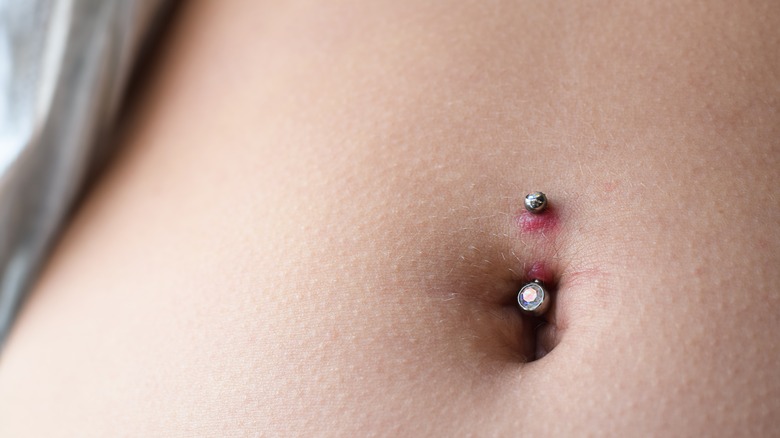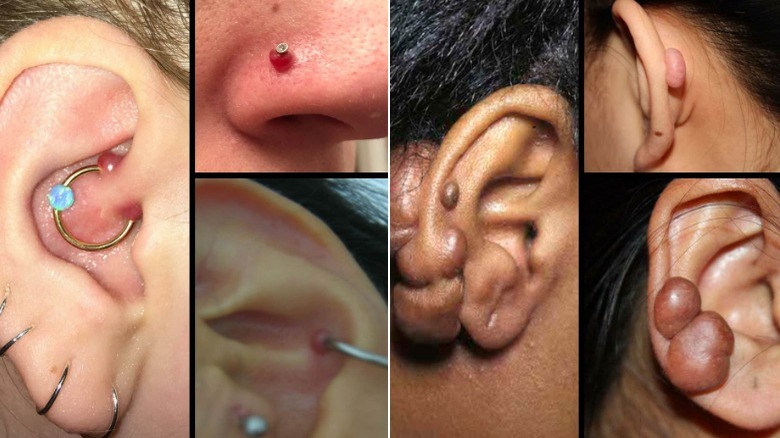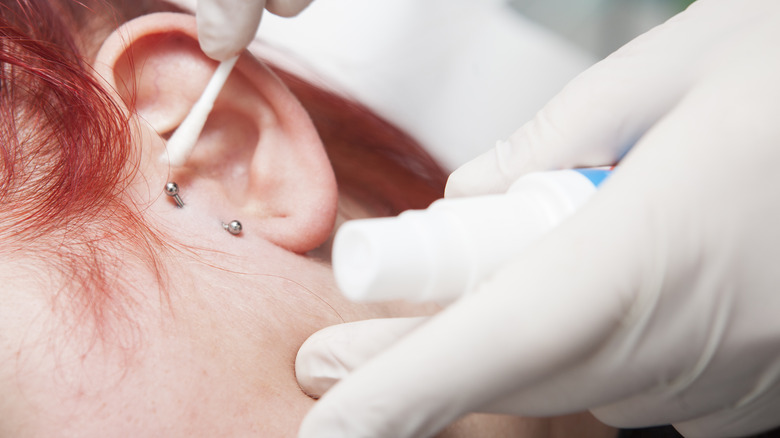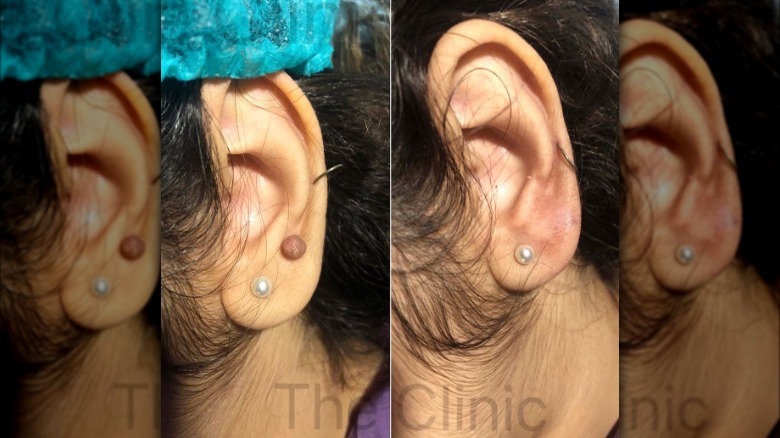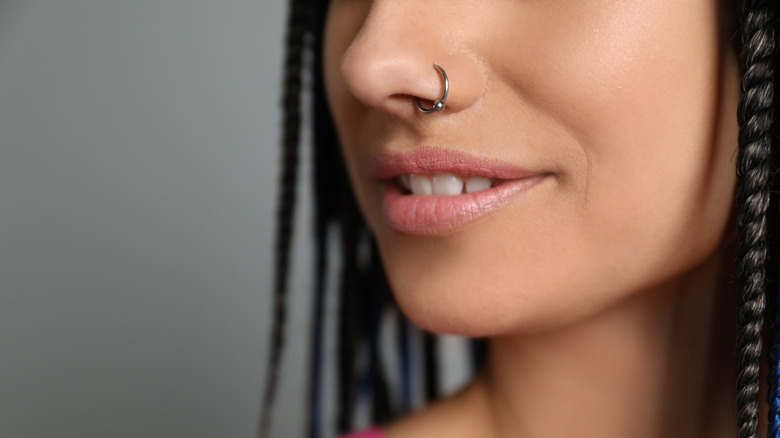How A Keloid Differs From A Typical Piercing Bump
Conch piercings and nose piercings are some of the coolest piercings to get. They're a little bit rebellious and they also are some of the most noticeable piercings — plus they just look cool. But anyone who's ever gotten their nose pierced knows about the dreaded piercing bump. Whether you experienced the bump yourself or not, it's kind of always on your mind since it is so common. And if you did get a bump, you know that it's also very hard to live with. It can make you so self-conscious and it can feel like nothing can get rid of it. Even though a lot of times people call this bump a keloid, it's actually not one.
Now, keloids can still form on piercings on cartilage or other areas of your body, but keloids are big scars that can also form from having acne, getting bit by a bug, getting a vaccine, or just cutting yourself on something. We'll get into why that is, but keloids are how some people's body scars. They're noticeable and big, but they're also not the typical piercing bump you might see or be dealing with yourself. Here's how to tell the difference between piercing bumps and keloids — rather than piercing infections — and how to treat them.
What is a keloid?
As Healthline reported, keloids are raised scars that occur after injury (or a piercing in this case). It's similar to regular scars in how it's formed, which is that the skin is trying to heal itself by forming fibrous tissue (scar tissue) over the wound to close it up. However, a keloid is when "extra scar tissue grows, forming smooth, hard growths." Keloids are also different than hypertrophic scars (also raised scars) in the way that they can extend past the piercing site or wounded area.
It takes months for a keloid to form, and some symptoms include itchy patches, raised areas of skin, or a growing area of skin. Healthline reported that 10% of people can get keloids, and you're more susceptible to them if you have darker skin. Other "more prone" groups include those that are Asian, Latino, pregnant, or under 30. If your parents get keloids or it runs in your family, you can bet you have a higher chance of getting them too.
What is a piercing bump?
Keevs reported that piercing bumps are "small lumps that can form immediately following a piercing." That seems pretty self-explanatory, right? It happens on (mostly) cartilage that has been pierced because it's a thicker part of the body to go through. It can also form on areas you've pierced that experience a lot of trauma (aka bumping and snagging), such as belly buttons. As Keevs wrote, it's all due to your immune system doing what it does best, which is trying to heal a wound, i.e. the new piercing. The bump might feel hot or look infected, but really it's just inflamed due to your body reacting to a new hole in it.
The area or the bump itself could be itchy and even some white "discharge" could come out of the site. These piercing bumps can also be a pyogenic granuloma. As Juliette Metts wrote (via The National Library of Medicine), a granuloma is a red or brown lesion that can come about 6 weeks post-piercing. A granuloma is also the bump that most likely comes to mind when you picture a piercing bump.
The difference between piercing bumps and keloids
We've already explained how to visually differentiate between keloids and piercing bumps. But as skincare physician Dr. Shehla Ebrahim wrote on her website, there are a few key differences between the two. For one, keloids are permanent while a piercing bump can go away if properly taken care of. In that regard, piercing bumps are under the skin (even though they're visible) and keloids form on top of the skin. As stated above about keloids, they can continue to grow outside of the wounded or pierced area, whereas a piercing bump is going to stick to the site of the piercing. And while neither is harmful to your health, keloids need to be seen by a doctor in order to get rid of them. As Dr. Ebrahim explained, even removing the jewelry isn't going to reverse a keloid.
Also, how they're formed is quite different. Obviously, we know they can both occur after a piercing, but piercing bumps form because of trauma to the new piercing site or incorrect placement or technique from the piercer. Keloids, however, are going to form because that's how your body makes scars. Again, if you know keloids run in your family or you're more predisposed to them, or you have them from other injuries, you're likely going to get a keloid from a new piercing — especially if it's through cartilage.
How to prevent bumps after piercing
Knowing how these bumps form will help to potentially prevent them. As stated above, Dr. Sheila Ebrahim wrote that piercing bumps form because of trauma to the piercing site (accidentally pulling on the jewelry or snagging it). You can also get a piercing bump if you have jewelry that doesn't fit your ear properly, such as a bar that's too short or too thick for your anatomy. Using a cheap metal for your jewelry is a big no-no, along with piercing it at a bad angle. You're also more likely to get a piercing bump if you are under a lot of stress, have hormonal changes, or have a cold when getting pierced.
To prevent piercing bumps, you want to make sure you have the best metal possible. Cheaper material is going to be anything other than surgical steel or solid gold. A good piercer should know how to choose this (and the size) correctly along with how to pierce at the proper angle. Searching up reviews of your piercer for the piercing you want can help narrow that down. And you want to be very careful with your new piercing so that you don't cause undue trauma to it.
Make sure you're cleaning your piercing properly so it has the best chance to heal — this goes for all new piercings. When it comes to keloids, it's a bit harder to prevent because of the fact that they form based on how your body reacts to wounds.
How to get rid of keloids
Keloids are typically permanent. Keevs notes that corticosteroids are one way to help shrink or reduce keloids. It's a medicine that's injected, and they report that doctors typically recommend four shots of it, once a month or so. Corticosteroids reportedly help shrink a large number of patients' keloids.
Even though keloids are just very hard bumps to remove or get rid of, corticosteroids shrink between 50% to 80% of patients' keloids, per Keevs. But topical treatments aren't really going to cut it for most keloids. You also can't, and shouldn't, try to remove them on your own, since that's not possible without a medical professional. Basically, seeing a doctor and getting it surgically removed is going to be your best bet if you want it gone. But know that they have the ability to reappear after it's already formed, so talk to your doctor about how to prevent that from happening after removal. They also note that laser therapy and cryotherapy have been reported to get rid of keloids.
How to get rid of piercing bumps
Piercing bumps, again, are not permanent. You want to get it as clean as possible, so look for a fragrance-free antimicrobial soap according to Healthline. Salines and sea soaks can be a good option if cleaning it won't do the trick. Don't use typical wound cleaning products like rubbing alcohol and hydrogen peroxide.
A warm chamomile compress also does wonders (via Healthline). This is when you steep a chamomile tea bag in water for about four to six minutes, let it cool enough to touch, and then gently apply it to the affected piercing site. Hold it there for five to 10 minutes (keep warming it up if it gets cold). Make sure to rinse your piercing when done (and wash your hands before).
If it doesn't go away after trying these things, talking to your piercer is a great option too. You might be allergic to a certain metal or have bad-fitting jewelry in, so talking to someone with expertise in this is a great route to go. It's unfortunately all a process and can take some time to figure out how to fully get rid of your piercing bump. But it'll be worth it in the long run, once it's gone and you can fully enjoy your piercing.
